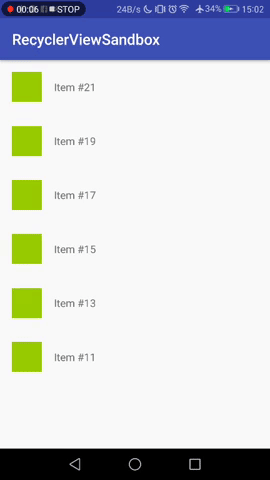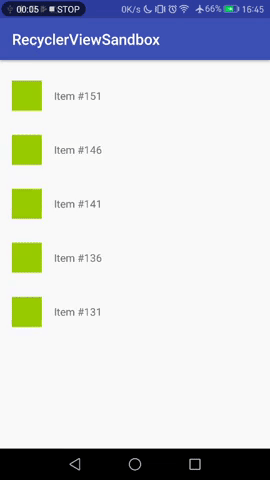在零位置插入RecyclerView项-始终保持滚动到顶部
我有一个非常标准的RecyclizerView,带有垂直的LinearLayoutManager。我一直在顶部插入新项目,并调用 notifyItemInserted(0)。<
我希望列表保持滚动到顶部;总是显示第0个位置。
从我的需求的角度来看,< code>LayoutManager根据项目的数量表现不同。
虽然所有项目都适合屏幕,但它的外观和行为与我预期的一样:新项目总是出现在顶部,并移动其下的所有项目。

但是,一旦项目数超过RecyclerView的界限,新项目就会添加到当前可见项目的上方,但可见项目仍会保留在视图中。用户必须滚动才能看到最新的项目。

这种行为是完全可以理解的,对于许多应用程序来说也很好,但对于“实时提要”来说就不是了,在“实时提要”,看到最新的东西比用自动滚动“不分散”用户注意力更重要。
我知道这个问题几乎是在RecyclerView的顶部添加新项目的重复...但是所有提出的答案都只是权宜之计(无可否认,其中大部分都相当不错)。
我正在寻找一种方法来真正改变这种行为。我希望LayoutManager的行为完全相同,无论项目数量如何。我希望它总是移动所有项目(就像它对前几个添加所做的那样),而不是在某个时候停止移动项目,并通过平滑地将列表滚动到顶部来进行补偿。
基本上,没有< code > smoothScrollToPosition ,没有< code > RecyclerView。SmoothScroller。子类化< code > linearrayoutmanager 就可以了。我已经在挖掘它的代码,但是到目前为止没有任何运气,所以我决定问一下,以防有人已经处理了这个问题。感谢任何想法!
编辑:为了澄清为什么我拒绝回答相关问题:我主要关心动画的平滑度。
请注意,在第一个GIF中,ItemAnimator在添加新项目的同时移动其他项目,淡入和移动动画的持续时间相同。但是当我通过平滑滚动“移动”项目时,我无法轻松控制滚动的速度。即使使用默认的ItemAnimator持续时间,这看起来也不太好,但在我的特定情况下,我甚至需要减慢ItemAnimator的持续时间,这使情况变得更糟:

共有3个答案
这对我有用:
val atTop = !recycler.canScrollVertically(-1)
adapter.addToFront(item)
adapter.notifyItemInserted(0)
if (atTop) {
recycler.scrollToPosition(0)
}
我还显示了一个项目的实时提要,当添加一个新项目时,它位于第一个项目之前。但在回收器视图中,我需要向上滚动以查看新项目。
要解决这个问题,请向适配器添加一个< code > RecyclerView。AdapterDataObserver()并覆盖< code > onItemRangeInserted()。添加新数据时,检查数据是否在位置0,回收器视图是否在顶部(如果在列表中滚动,您不希望自动滚动到第一个位置)。
例如:
adapter.registerAdapterDataObserver(new RecyclerView.AdapterDataObserver() {
@Override
public void onItemRangeInserted(int positionStart, int itemCount) {
super.onItemRangeInserted(positionStart, itemCount);
if (positionStart == 0 && positionStart == layoutManager.findFirstCompletelyVisibleItemPosition()) {
layoutManager.scrollToPosition(0);
}
}
});
这个解决方案对我来说很好,使用不同类型的适配器,如ListAdapter和PagedListAdapter。我首先想使用已接受解决方案的类似实现,在其中添加一个愚蠢的第一项,但在PagedListAdapter中,这是不可能的,因为列表是不可变的。
虽然我写了这个答案,而且这是公认的解决方案,但我建议在尝试之前先看看其他的答案,看看它们是否对你有用。
当一个项目被添加到<code>RecyclerView
如果新项目在不滚动的情况下无法显示,则不会创建视图持有者,因此没有任何动画。当这种情况发生时,将新项目放到屏幕上的唯一方法是滚动,这会导致创建视图持有者,以便视图可以在屏幕上布局。(似乎确实存在视图部分显示并创建视图持有者的边缘情况,但我将忽略这个特定实例,因为它与此无关。)
因此,问题是两个不同的动作,添加视图的动画和添加视图的滚动,必须让用户看起来相同。我们可以深入到底层代码中,并精确地计算出视图控件创建、动画计时等方面发生了什么。但是,即使我们可以复制这些动作,如果底层代码发生变化,它也可能会中断。这就是你所抗拒的。
另一种方法是在< code > recycle view 的零位置添加一个标头。当显示此标题并将新项目添加到位置1时,您将始终看到动画。如果你不想要一个标题,你可以把它设置为零高度,这样它就不会显示了。以下视频展示了这种技术:
这是演示的代码。它只是在项目的位置0添加了一个虚拟条目。如果你不喜欢虚拟条目,还有其他方法。您可以搜索将标题添加到< code > recycle view 的方法。
(如果您确实使用了滚动条,它将出现错误,正如您可能从演示中看到的。要100%修复此问题,您必须接管大量的滚动条高度和位置计算。<code>LinearLayoutManager</code>的自定义<code>computeVerticalScrollOffset()
MainActivity.java
public class MainActivity extends AppCompatActivity implements View.OnClickListener {
private TheAdapter mAdapter;
private final ArrayList<String> mItems = new ArrayList<>();
private int mItemCount = 0;
@Override
protected void onCreate(Bundle savedInstanceState) {
super.onCreate(savedInstanceState);
setContentView(R.layout.activity_main);
RecyclerView recyclerView = (RecyclerView) findViewById(R.id.recyclerView);
LinearLayoutManager layoutManager =
new LinearLayoutManager(this, LinearLayoutManager.VERTICAL, false) {
@Override
public int computeVerticalScrollOffset(RecyclerView.State state) {
if (findFirstCompletelyVisibleItemPosition() == 0) {
// Force scrollbar to top of range. When scrolling down, the scrollbar
// will jump since RecyclerView seems to assume the same height for
// all items.
return 0;
} else {
return super.computeVerticalScrollOffset(state);
}
}
};
recyclerView.setLayoutManager(layoutManager);
for (mItemCount = 0; mItemCount < 6; mItemCount++) {
mItems.add(0, "Item # " + mItemCount);
}
// Create a dummy entry that is just a placeholder.
mItems.add(0, "Dummy item that won't display");
mAdapter = new TheAdapter(mItems);
recyclerView.setAdapter(mAdapter);
}
@Override
public void onClick(View view) {
// Always at to position #1 to let animation occur.
mItems.add(1, "Item # " + mItemCount++);
mAdapter.notifyItemInserted(1);
}
}
TheAdapter.java
class TheAdapter extends RecyclerView.Adapter<TheAdapter.ItemHolder> {
private ArrayList<String> mData;
public TheAdapter(ArrayList<String> data) {
mData = data;
}
@Override
public ItemHolder onCreateViewHolder(ViewGroup parent, int viewType) {
View view;
if (viewType == 0) {
// Create a zero-height view that will sit at the top of the RecyclerView to force
// animations when items are added below it.
view = new Space(parent.getContext());
view.setLayoutParams(new ViewGroup.LayoutParams(ViewGroup.LayoutParams.MATCH_PARENT, 0));
} else {
view = LayoutInflater.from(parent.getContext())
.inflate(R.layout.list_item, parent, false);
}
return new ItemHolder(view);
}
@Override
public void onBindViewHolder(final ItemHolder holder, int position) {
if (position == 0) {
return;
}
holder.mTextView.setText(mData.get(position));
}
@Override
public int getItemViewType(int position) {
return (position == 0) ? 0 : 1;
}
@Override
public int getItemCount() {
return mData.size();
}
public static class ItemHolder extends RecyclerView.ViewHolder {
private TextView mTextView;
public ItemHolder(View itemView) {
super(itemView);
mTextView = (TextView) itemView.findViewById(R.id.textView);
}
}
}
activity_main.xml
<android.support.constraint.ConstraintLayout
android:layout_width="match_parent"
android:layout_height="match_parent"
android:orientation="vertical"
tools:context=".MainActivity">
<android.support.v7.widget.RecyclerView
android:id="@+id/recyclerView"
android:layout_width="0dp"
android:layout_height="0dp"
android:scrollbars="vertical"
app:layout_constraintBottom_toTopOf="@+id/button"
app:layout_constraintStart_toStartOf="parent"
app:layout_constraintEnd_toEndOf="parent"
app:layout_constraintTop_toTopOf="parent" />
<Button
android:id="@+id/button"
android:layout_width="wrap_content"
android:layout_height="wrap_content"
android:layout_marginBottom="8dp"
android:layout_marginEnd="8dp"
android:layout_marginStart="8dp"
android:text="Button"
android:onClick="onClick"
app:layout_constraintBottom_toBottomOf="parent"
app:layout_constraintEnd_toEndOf="parent"
app:layout_constraintStart_toStartOf="parent" />
</android.support.constraint.ConstraintLayout>
list_item.xml
<LinearLayout
android:id="@+id/list_item"
android:layout_width="match_parent"
android:layout_height="wrap_content"
android:layout_marginTop="16dp"
android:orientation="horizontal">
<View
android:id="@+id/box"
android:layout_width="50dp"
android:layout_height="50dp"
android:layout_marginStart="16dp"
android:background="@android:color/holo_green_light"
app:layout_constraintBottom_toBottomOf="parent"
app:layout_constraintStart_toStartOf="parent"
app:layout_constraintTop_toTopOf="parent" />
<TextView
android:id="@+id/textView"
android:layout_width="wrap_content"
android:layout_height="wrap_content"
android:layout_marginStart="16dp"
android:textSize="24sp"
app:layout_constraintBottom_toBottomOf="parent"
app:layout_constraintStart_toEndOf="@id/box"
app:layout_constraintTop_toTopOf="parent"
tools:text="TextView" />
</LinearLayout>
-
问题内容: 我的问题是当我在回收视图中滚动数据时,所以加载了新数据,但问题是当新数据加载时,回收视图从第一个产品开始, 我需要保持旧的位置,只滚动新数据,而不滚动所有旧数据 目前,我正在添加文件adeptoer文件和主文件的完整代码, 问题答案: 试试这个:
-
问题内容: 我如何避免滚动页面的其余部分?我考虑过使用和,只是想知道是否有更简单,更用户友好的方法,这样做的最佳实践是什么? 问题答案: 使用的包含您的头,喜欢的东西 在此示例中,当开始时位于下方100px处,但随着用户滚动,它保持原位。当然,不用说,您需要确保有背景,以便当两个s重叠时,其内容实际上是可见的。
-
问题内容: 这是我的onCreate,它处理适配器,LinearLayoutManager等。我尝试了每个选项以尝试将其滚动到顶部,但不能。我什至尝试创建自己的自定义LinearLayoutManager。 问题答案: 您尝试过还是? RecyclerView不会在其中实现任何滚动逻辑,而是更加具体,它会根据实现的布局转到特定的索引,在您的情况下是线性的。
-
如何刷新显示在中的数据(在其适配器上调用),并确保滚动位置被重置到它原来的位置? 如果是良好的ol'则只需检索,检查其,然后使用相同的精确数据调用。 在的情况下,这似乎是不可能的。 我想我应该使用它的,它确实提供了,但是检索位置和偏移量的正确方法是什么? 和? 还是有更优雅的方法来完成这项工作?
-
问题内容: 我正在MVC中从事一个项目,并且对此有所了解。有一些成长的烦恼,但一旦您找出来,那还不错。在WebForms世界中,真正简单的一件事是保持页面上的滚动位置。您所要做的只是将MaintenanceScrollPositionOnPostback属性设置为true。但是,在MVC中,我不使用回发,因此这对我不起作用。处理此问题的标准方法是什么? 编辑: Ajax是可以接受的,但我也想知道如
-
我有一个和一个,它由一个带有不同高度项的适配器支持。有没有办法告诉设置滚动位置,使项目X(或多或少)准确地出现在屏幕底部?

